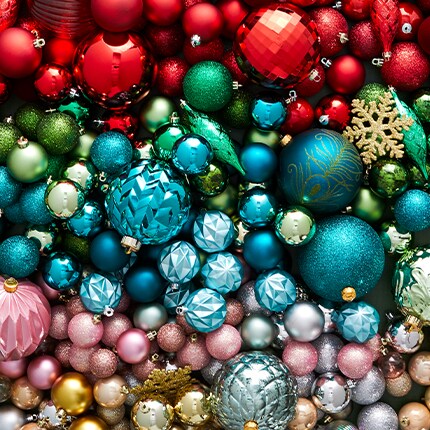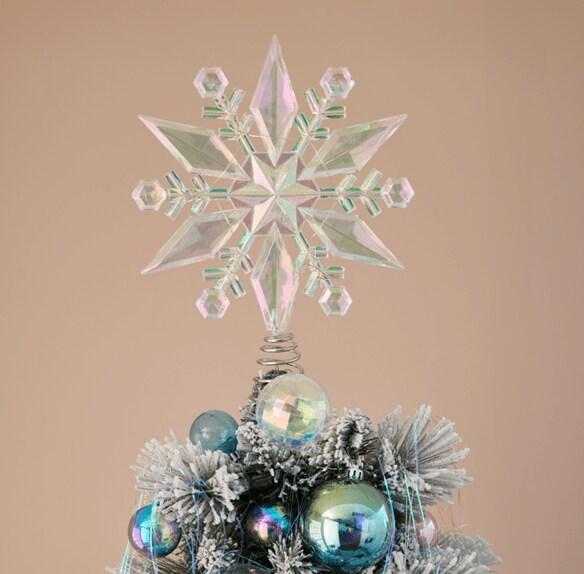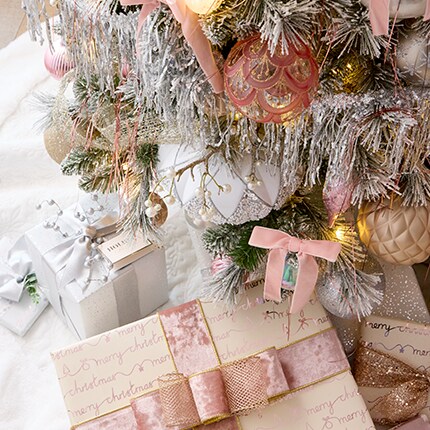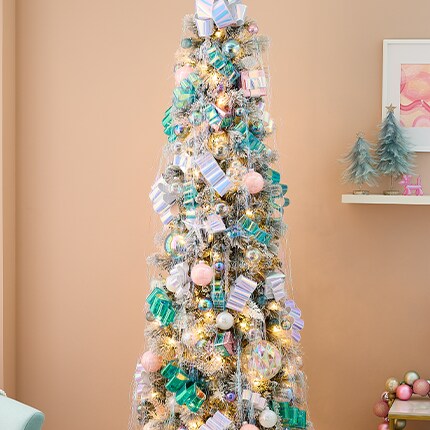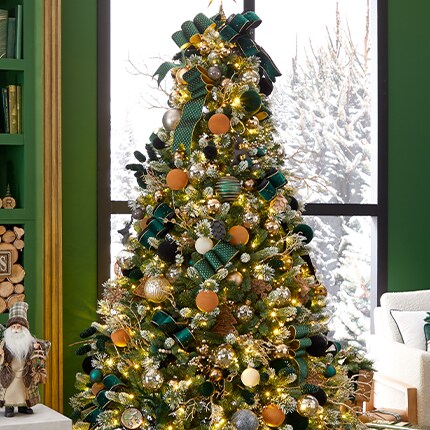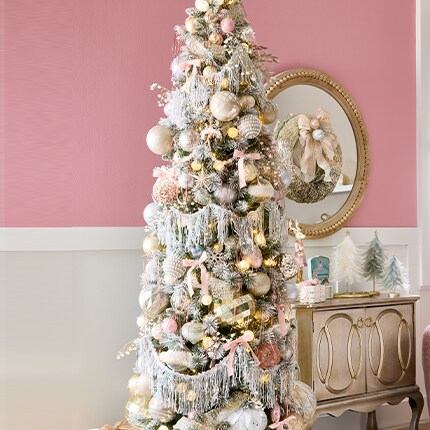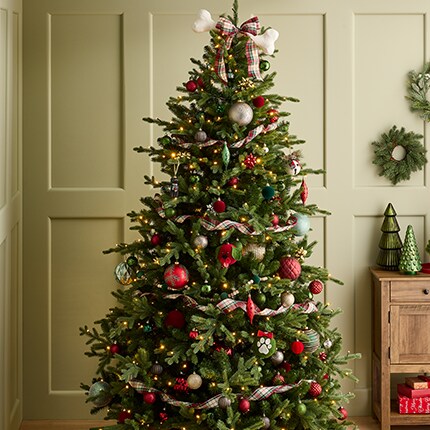Christmas Tree Buying Guide
Christmas Tree Buying Guide
We all know the holiday season can be a very hectic time, especially with Christmas creeping up on us seemingly faster each year. The last thing you need is the stress of constantly wondering “which Christmas tree should I buy?”. That’s why we've created this comprehensive Christmas tree buying guide—to help you make the best and easiest choice for you when selecting the centerpiece of your festive decorations.
Whatever style or form your holiday décor takes, we can offer the perfect Christmas tree to tie it all together, and our guide will help you make the most informed decision possible.
Real vs. Artificial Christmas Trees
The first—and arguably the most important—decision you’ll need to make when Christmas tree shopping is whether to get an artificial Christmas tree or a real one. This choice will dictate most, if not all, of the other tree-related decisions you will go on to make, so it’s important to consider your options wisely. Both real Christmas trees and artificial ones come with their own pros and cons, unique features, and creative limitations. Let's take a look at what some of these are.
Real Christmas Tree Types and Features
Real Christmas trees come in a range of species, each with distinct characteristics that affect appearance, fragrance, needle retention and branch strength. Popular options include:
Fraser Fir: known for excellent needle retention and sturdy branches.
Douglas Fir: offering a classic conical shape and sweet scent.
Balsam Fir: favored for its rich fragrance and dense foliage.
Noble Fir: with strong branches and bluish-green needles.
Nordmann Fir: less fragrant, but has soft needles and exceptional longevity indoors.
When choosing a real tree, factors like the feel of the needles, the scent level, and how well the tree holds ornaments all come into play. Softer needles make trees more child- and pet-friendly, while ones offering a more rigid structure can carry heavier and more elaborate decorations.
For example, a freshly cut real tree will bring that beautiful evergreen aroma into your home. Not to mention, going out with your family to choose the perfect tree is part of the Christmas experience for many and a generational tradition.
Of course, real trees come with some responsibilities. You'll need to prepare your space and ensure you can maintain and care for the tree while it's in your home.
Artificial Christmas Tree Types and Features
Artificial trees are much easier to maintain, as they don't shed needles or require water. Many of the artificial trees in stores today are made to be life-like in style and type. You can also find them in different colors, such as white, to add something special to your holiday décor. There are plenty of types to choose from as well:
- Pre-lit trees come with the lights attached for no-fuss decoration and assembly.
- Pre-decorated trees come with all the bows and ornaments attached already.
- Flocked trees add a bit of winter wonderland to your living room with fake snow.
- Colorful trees can match the décor of your house or other Christmas decorations.
When buying an artificial Christmas tree, the main factor that comes into play is the price. A quality artificial Christmas tree won't be cheap, especially since they're made to last year after year for a decade or more. Of course, you also want to ensure that you are buying something that lasts for years to come, which is why it's best to shop around and get to know the price points and materials used before pulling out your credit card.
Turn Your Tree Into a Showstopper
Toppers, lights, ornaments & skirts—shop the finishing touches that wow every guest!
Figuring Out Your Christmas Tree Style
Before you choose your tree, it’s worth weighing up what you’re looking for. Your Christmas tree "style" will depend on who you are as a person, your circumstances, and how you like to decorate for the holidays.
- Do you want your tree to match your home decor, or stand out? For example, if you have a minimalist home, you might want a fully white tree or a slimmer-shaped one.
- How much space do you have? Measure your space floor-to-ceiling and leave about a foot of space to account for the tree stand and topper. Also consider how wide your tree should be, and remember that trees often appear smaller in-store than in your home.
- What colors are you looking for? A classic green is timeless, while flocked snow can add a winter wonderland edge to your décor.
- Are you looking for special features? Many trees today come pre-lit, and some of these come with different lighting effects to inject extra fun into the look.
- What decorations do you have already? Do you love DIY decorations, or polished color-coded ornaments that would blend into the background of any Hallmark movie? The right tree should complement what you already have—unless you’re planning a much-needed Christmas decoration shopping spree for new baubles, lights, tree skirts, and toppers.
With artificial trees, another key consideration is how realistic you want it to look, whether you want it pre-lit, decorated, potted, and so on. If you’re still unsure, don’t worry—we’ll cover all of that below.
14 Types of Artificial Christmas Trees
When it comes to artificial trees, you have a lot more options to choose from. Those options will vary, however, by specific categories from needle type to color.
1. PVC
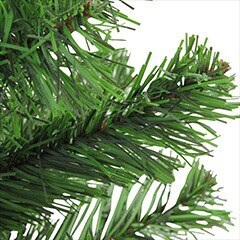
Best for: Nostalgia and affordability
PVC Christmas trees are durable and affordable. They've been around since the 1930s, and the materials are cut into long rectangular-like shapes with flat surfaces. Once twisted into the tree branches, the PVC gives the illusion of thick and full branches ready to hang all sorts of ornaments.
These trees will need the most shaping when you take them out of the box or storage, and their somewhat stringy look can make them seem less realistic than pricier alternatives. However, if you’re looking for an almost vintage-style Christmas tree that matches the one from your happiest childhood memories, PVC Christmas trees will suit your needs perfectly.
2. PE - Ultra-Realistic
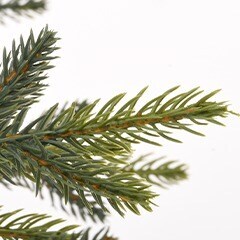
Best for: Ultra-realistic branches
PE Christmas trees are sure to have people asking, “How did you find the time to buy a real tree?” This is because PE needles were designed and manufactured to resemble real Christmas trees. The "needles" on these ultra-realistic trees appear lush and tapered, which gives the tree a multi-dimensional look and feel.
The ultra-realistic types of trees are usually a little more expensive, but they also last longer than PVC trees. They also look better, in our opinion, and require less shaping when they’re fresh out of the box!
3. PE & PVC
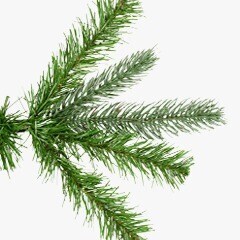
Best for: A mix of affordability and realism
The PE and PVC combo makes for an affordable, "realistic" tree option. The PVC materials offer fullness to the tree while the PE materials make it look much more realistic compared to that of the PVC material. The PVC provides a full shape, while the PE is usually placed sparingly on the outermost branches of the tree to lend an air of realism to the look.
While these aren’t the most ultra-realistic trees, you'll still get the natural look you desire for a reasonable price point.
Now, Let's Talk Tree Styles
We just covered the base elements of your tree. But there are additional variations that can completely change the look of your tree, regardless of if you pick PVC, PE, or a combination of the two.
4. Flocked
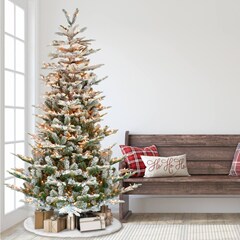
Best for: Creating a winter wonderland in your living room
Flocked Christmas trees are very popular as they bring the essence of winter into the home. The branches on these trees are lightly dusted with "sparkling snow" to provide a white Christmas aesthetic.
This style actually works best in homes with more neutral and minimalist decor, but they’re suitable for anyone who wants a more "outdoorsy" feel to go with the rest of their decorations.
5. Fiber Optic
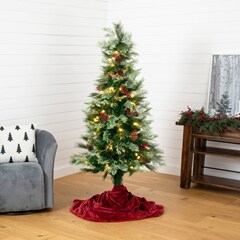
Best for: Creating a futuristic effect
Fiber optic trees are shimmery, modern, and super easy to use. This style features mini lights placed on the tips of the tree's branches either throughout the entire tree or more sparsely placed. This adds a nice warm glow to the tree, and you can find color-changing options as well.
Fiber optic trees also use LED lights, which ensures that the trees stay cool to the touch—so you don't have to worry about overheating, burnt-out bulbs, or fires.
6. Pre-Lit
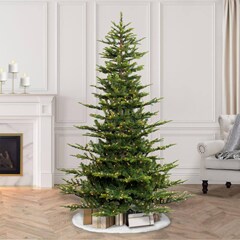
Best for: Saving time untangling string lights
Pre-lit style Christmas trees are another popular glimmering option since the LED lights are already installed. All you have to do is take the tree out of its box, assemble it, add your ornaments, and you're good to go.
Just like the fiber optic style, you can choose from various color options. Just keep in mind, the lights are sewn into the branches, so you won't be able to change them.
7. Unlit
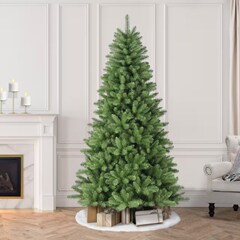
Best for: Decorating your tree the old-fashioned way
Unlit artificial Christmas trees remain at the top of the list for those who prefer to handle all the decorations. They come in the same sizes and shapes as all the other trees, and they allow you and your family the option to continue your Christmas tree decorating traditions. You can also update the lights or replace them if a few break.
These trees are probably the most traditional, and allow you the most creativity around decorating, whether you’re using classic ornaments and tinsel or DIY decorations.
8. Decorated
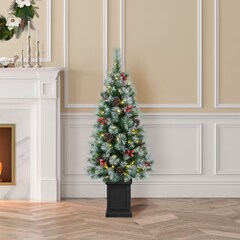
Best for: Creating a cohesive look on your tree
Fully-decorated artificial trees are also an option. This style comes fully stacked with lights, ornaments, and other accessories, such as bows and even tree collars. Pre-decorated trees make holiday decorating easy for those who don't have the time to decorate or storage space for both a tree and decorations and other accessories.
Of course, the decorations usually come attached to the tree, so there's no changing them up if you're thinking about updating your holiday aesthetics. But on the other hand, you can spend more time enjoying the holidays and less time untangling string lights!
9. Upside Down

Best for: Adding an air of whimsy to your living room
Upside-down trees are exactly what they sound like—artificial trees made to hang upside down from your ceiling with the top facing the floor. This style of tree makes for a fun conversation piece during holiday parties.
Upside-down trees are also great for smaller homes and apartments, especially those with cats and other small animals that enjoy climbing and destroying your holiday décor.
10. Potted
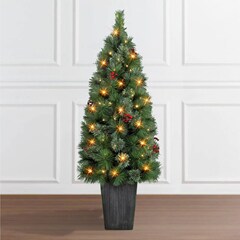
Best for: A more natural look
Potted trees are typically associated with the farmhouse aesthetic, and they're a great option for when you want a realistic look. You'll find a variety of potted options, some more glamorous and ornate, and others plain and to the point.
They also make for great outdoor Christmas decorations, as they can be used to frame doorways and walkways if you want to bring the holidays out of your home.
11. Tinsel and Colorful Trees

Best for: Matching the rest of your décor in a festive way
There's always a primary focus on finding the perfect artificial tree that perfectly resembles real trees. However, you always have the option to spice things up with a retro or contemporary look—even if it's just for one holiday season.
The best thing about tinsel and colorful trees is that they don't appear as fake or tacky as you may be imagining in your mind right now. You can find a variety of options, like gold tinsel trees, or shimmering white trees that not only make a statement but can really jazz up your holiday décor.
Moving On to Tree Profiles
Finally, you’ll need to consider the rough shape of the tree. Full and classic, slim and elegant, or something a little more unique? There’s truly a tree out there to suit every taste!
12. Full Trees
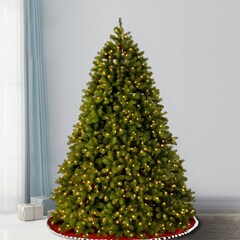
Best for: Creating that classic “Christmas tree” silhouette
The most commonly sought-after tree profiles are the full trees. They're essentially the ultimate Christmas symbol, as they take on that classic and traditional form you see in all the holiday movies and illustrations.
You can think of the shape like an upside-down triangle or cone—narrow at the top, filling out more and more towards the bottom with a wider base. If you're into the classic Christmas tree look, then this is the profile option for you.
13. Pencil Trees
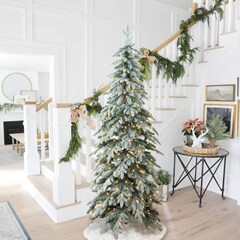
Best for: A more minimalist look and smaller rooms
Pencil trees have a profile that's significantly skinnier than that of a full tree. While most pencil profiles are on the thin side, you'll find some varieties that do offer a broader appearance. However, they always maintain a slender and modern silhouette.
The exact broadness of a pencil tree will vary based on its height and the manufacturer. Of course, they're all perfect for smaller homes and apartments that don't have the space for a full tree.
14. Naturally Imperfect Trees
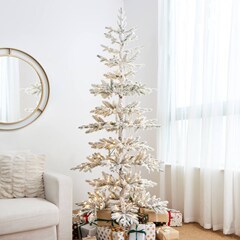
Best for: Creating a unique look every holiday season
Usually, when we talk about imperfect trees, the Charlie Brown Christmas tree comes to mind. However, that's not the case with the naturally imperfect profile option. These artificial trees are made with fewer branches and needles than the fuller artificial tree, which gives them a more organic appearance.
The imperfections refer to sparse needles and crooked branches, creating a more natural and minimalistic look.
The Benefits of Artificial Christmas Trees
While no artificial tree can perfectly capture the essence (and woodsy scent!) of a real tree, the benefits definitely outweigh the drawbacks:
Relaxation. Artificial trees are low-maintenance, as they don’t require any watering or constant hoovering of fallen needles. If you fall behind on chores over the holiday period, artificial trees won’t punish you for it.
Longevity. Artificial trees can last a decade or more if you invest in a high-quality model. So, while your initial investment can seem like a lot, they are budget-friendly in the long run.
Creativity. You can’t put a limit on the amount of styles, features, and colors you’ll find in artificial trees. You can, however, find the tree that perfectly expresses how you want to feel at Christmas time, whether that’s or bright and covered in!
Ease of setup. Artificial trees are more durable than real trees,and are also generally easier to set up once you have them at home. Simply stack all the parts correctly, and your tree is ready for decoration! No hassle with tree stands and remembering to water them every few days.
Safety. Where live trees can be a fire risk, artificial trees are generally less flammable, and can be considered a safer alternative. You also won’t trigger any allergies with an artificial tree, which is a great bonus!
How to Choose Your Artificial Christmas Tree
Now that you have all the facts, it’s time to choose your artificial Christmas tree.
Measure your space and choose a tree that leaves ample room for your topper to shine. Look into or if you’re short on space.
Decide on your desired aesthetic. Color, shape, and needle type—classic PVC or hyper-realistic PE?
Consider ease of setup. Look for hinged branches and trees that come in easy-to-assemble sections. These won’t just be easier to set up, but they’ll be easier to store as well!
Decide on any bonus features, nice-to-haves, or additional essentials like pre-lit, pre-decorated, flocked, or even remote-controlled trees.
When to Buy Your Artificial Christmas Tree
When it comes to buying an artificial Christmas tree, one main factor that comes into play is the price. A quality artificial Christmas tree won't be cheap, because they're made to last almost a lifetime. Of course, you also want to ensure that you are buying something that lasts for years to come, which is why it's important to do your research and buy at the smartest time.
With quality in mind, the best time to buy an artificial Christmas tree is technically whenever it's being offered at the right price. You can depend on all artificial trees to be at their most affordable when distributors are trying to move their excess inventory.
These times vary throughout the year, but typically include:
Black Friday
Cyber Monday
Immediately after Christmas (during post-Christmas sales)
Off-peak seasons
If you can wait, it's best to purchase your artificial tree either right before or right after Christmas day. However, if waiting isn't an option or you already have a specific tree in mind, then you'll want to try and buy it around.
If the cost isn't an issue, then you can go ahead and buy your artificial tree at any time. Just keep in mind that additional features like will likely bump up the price. Fortunately, they're made to last a long time which can save you money on extra decorations in the long run.
What is the Best Artificial Christmas Tree?
As you can see, there are tons of style combinations you can choose from and factors to consider, which can be a bit overwhelming. When in doubt, we suggest going for the, as it can be decorated differently each year. How realistic you want it to appear is entirely up to you!
If you’d like to explore the full range of options, browse Michael's and today.
Find the trend that fits your holiday aesthetic.
Artificial Christmas Tree FAQs
What are the benefits of choosing an artificial tree over a real one?
Artificial trees are reusable and less messy, and some options allow them to come pre-lit. They’re also hypoallergenic and safer for homes with pets. Additionally, artificial trees can last 8-12 years or longer, so it’s a great investment over time! You and your family can enjoy your tree year after year without cutting, mounting, watering, or cleaning up after fallen needles!
How can I make my artificial tree look fuller?
We suggest that you fluff the branches properly, add extra greenery, and use ornaments, ribbon, and whimsical Christmas tree décor to fill any gaps! This allows the tree to appear more full and festive.
What should be considered when choosing the shape of a Christmas tree?
When choosing the shape, consider the size of the space you are looking to fill, and the style you want! Full trees offer a traditional look, while slim or pencil trees are great for small spaces. We have a ton of options that will fit perfectly in your home.
Which foliage type looks the most realistic?
Fir, pine, and spruce trees are designed to replicate the look of real trees, with fir trees often considered the most realistic due to their dense, soft needles. Our trees have great detail to ensure they look authentic, mimicking a real tree.
Are pre-lit Christmas trees better than unlit ones?
Pre-lit trees save time and ensure even lighting, but unlit trees offer the flexibility to customize with your own lights. This allows you some flexibility to make sure your tree is lit perfectly.
We would love to hear from you!


